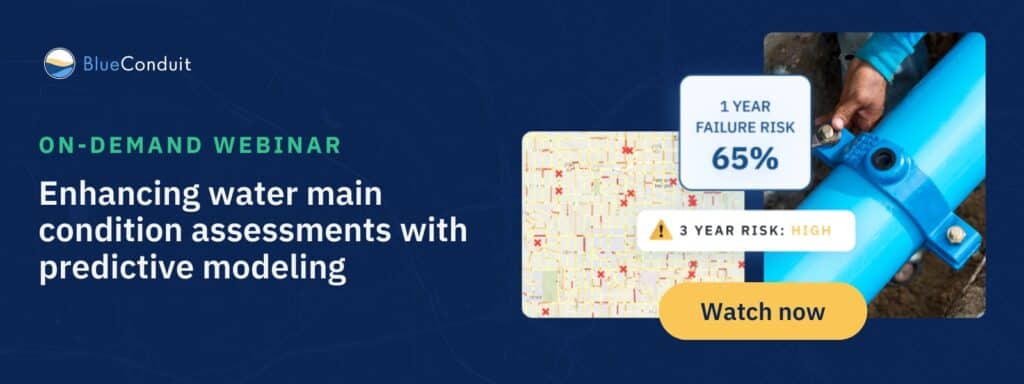During our recent webinar, “Enhancing water main condition assessments with predictive modeling,” an attendee asked this question:
How do you handle large diameter water mains, given that large diameter mains don’t tend to have break history?
We get asked this question a lot, and we get it. Large diameter water mains can be tricky from a predictive modeling perspective because their break history is limited yet the consequence and cost of an unexpected failure can be very high. And yet, predictive modeling can still be an effective tool to assess risk for large diameter mains.
How does it work? Our expert Chief Data Scientist, Jared Webb, broke it down like this.
For all of the models we train at BlueConduit, we let the data speak for itself. Even a small amount of large diameter water main break history can go a long way in teaching our models about how to predict risk for this category of mains. That said, if there is no break history on any of the large diameter mains in your system, our models will learn that, statistically speaking, large diameter does not increase the risk of failure for a water main.
However, our models can still help you assess likelihood of failure for these large diameter mains. When BlueConduit’s advanced AI algorithms and expert Data Scientists generate predictive models, they take the water main system and break data and enrich it with additional features including soil type and weather. All of this data contributes to a risk score; essentially, how likely is it that this water main will break in a given time period?
Any water main that shares the same conditions as the large diameter main will contribute to the risk score for the large diameter main. As the model learns which features contribute to failure risk for other water mains with a break history, these learnings support the generation of a risk score for each large diameter main.
These risk scores enable BlueConduit to rank the large diameter mains from highest to lowest risk of failure in a given time period. By highlighting large diameter water mains with the highest risk of failure, water systems can more proactively and efficiently direct resources for physical condition assessment, maintenance and replacement.
Finally, a major benefit of a human-in-the-loop predictive modeling process is that water systems we work with can talk directly to our data science team about qualitative knowledge that might not show up directly in the dataset. These conversations enable our Data Science team to account for this qualitative information during the modeling process, ensuring that every unique water system gets a model that best assesses their unique risks and needs.
Curious to learn more about how predictive modeling can help you get ahead of risk in your water main infrastructure? Watch our on-demand webinar today.






